
“Okely dokely, now I’m playing with power!”

You made a big mistake buddy.

“Okely dokely, now I’m playing with power!”

You made a big mistake buddy.
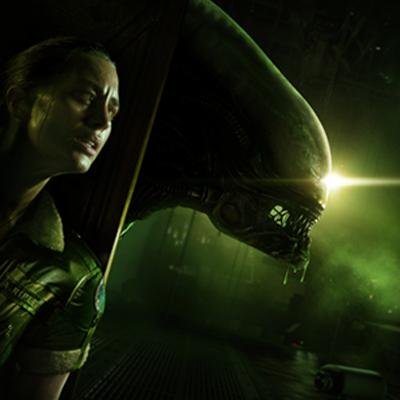 If running around a dark space station with a Xenomorph walkin’ around and a slight infestation of Facehuggers sounds fun to you then is this the game for you! Set 15 years after the first Alien film (we’ll get to those at a future date), you play as Ellen Ripley’s daughter, Amanda who is searching for clues regarding her mother’s disappearance. It turns out to be a very bad idea. Especially since they decided to add evil creepy androids into the mix.
If running around a dark space station with a Xenomorph walkin’ around and a slight infestation of Facehuggers sounds fun to you then is this the game for you! Set 15 years after the first Alien film (we’ll get to those at a future date), you play as Ellen Ripley’s daughter, Amanda who is searching for clues regarding her mother’s disappearance. It turns out to be a very bad idea. Especially since they decided to add evil creepy androids into the mix.
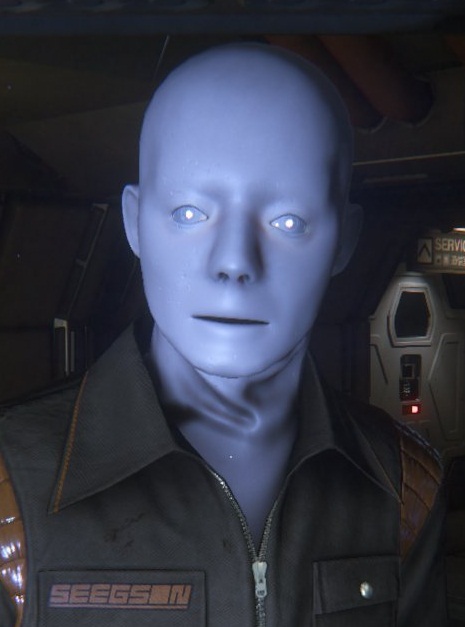
0_o

Fox “Spooky” Mulder in his element.

Dana Scully in her element.
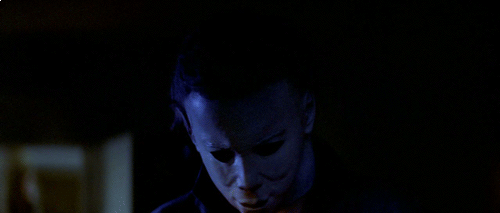
“Yes, I’ll accept the charges.”
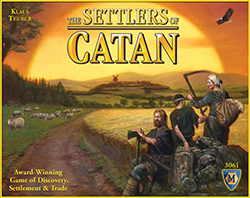
| Number of Players: | 3-4 |
| For Ages: | 10+ |
| Duration of Play: | 45-90 minutes |
In The Settlers of Catan you control a group of settlers trying to tame the wilds on the remote but rich island of Catan. Start by revealing the island’s many port sites and regions: plains, meadows, mountains, hills, forests, and desert. The random mix creates a different board for virtually every game. Then embark on a quest to settle the island. Guide your settlers to victory by clever trading and cunning development. Instead of money, you use combinations of resources – grain, wool, ore, brick, and timber – to purchase development cards or build roads, settlements, and cities. Acquire your resources through trades or the luck of the dice. But beware! Someone might cut off your road or buy a monopoly! And you never know when the robber will appear and steal away with your precious gains!Many thanks to UNT Gamers for gifting this title to the UNT Media Library! If you like The Settlers of Catan, you may also enjoy these titles, also available at UNT Media Library:— Mayfair Games
 |
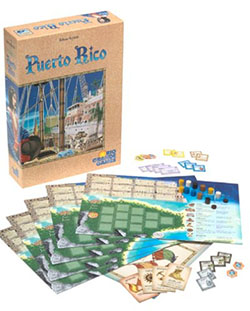 |
 |
Alhambra, Boardgame 201 |
Puerto Rico, Boardgame 93 |
Agricola, Boardgame 302 |
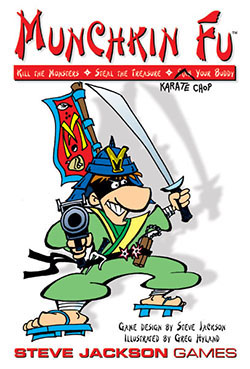
| Number of Players: | 3-6 |
| For Ages: | 10+ |
| Duration of Play: | 60-120 minutes |
Go down in the dungeon. Kill everything you meet. Backstab your friends and steal their stuff. Grab the treasure and run. Admit it. You love it. Munchkin is the mega-hit card game about dungeon adventure . . . with none of that stupid roleplaying stuff. You and your friends compete to kill monsters and grab magic items. And what magic items! Don the Horny Helmet and the Boots of Butt-Kicking. Wield the Staff of Napalm . . . or maybe the Chainsaw of Bloody Dismemberment. Start by slaughtering the Potted Plant and the Drooling Slime, and work your way up to the Plutonium Dragon . . . And it’s illustrated by John Kovalic!If you like Munchkin, you may also enjoy these titles, also available at UNT Media Library:— Steve Jackson Games
post by Julie Patterson
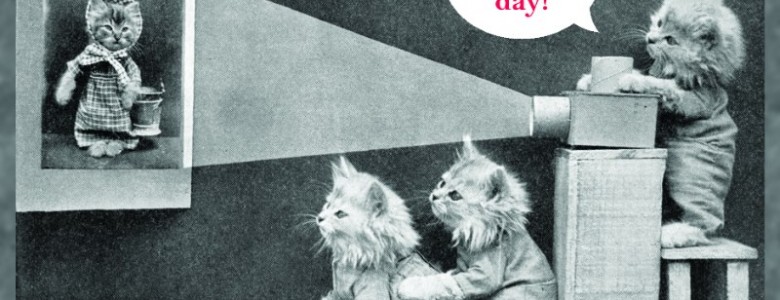
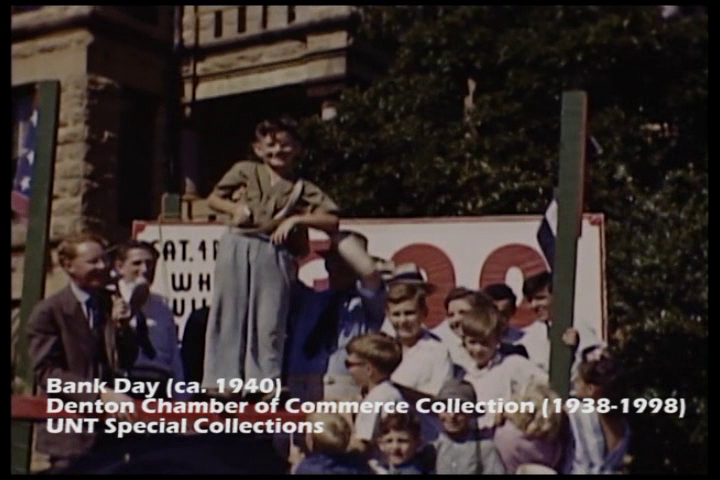 |
On November 22, 1963 Dallas clothing manufacturer Abraham Zapruder used his 8mm Bell & Howell film camera to document President John F. Kennedy’s motorcade as it passed through Dealey Plaza. This home movie, now referred to as “The Zapruder Film,” unexpectedly captured the assassination of President Kennedy and subsequently became one of the most analyzed films in history. Though most of us are familiar with this iconic film, we are perhaps less well-acquainted with the historical value of home movies as a genre. As noted by filmmaker and preservationist Martin Scorsese, home movies “do not just capture the important private moments of our family’s lives but they are historical and cultural documents as well.”
Officially celebrated across the world on October 17th, 2015, this year’s “Home Movie Day,” is an opportunity for individuals, families, and communities to see and share their home movies, to learn about the historical significance of home movies, and find out how to best preserve these valuable artifacts. Though your home movies may not capture nationally historic events, they do document and preserve cultural practices for current and future scholars. They tell us not only what kind of fashion people wore but also how they wore it. They visually preserve architecture and now-demolished skylines.They show us how people from different backgrounds celebrate holidays like birthdays and Thanksgiving. Better than a written account or still photograph, home movies are capable of showing how people actually lived.
For the month of October, the Media Library is celebrating Home Movies with an exhibit of home movie technologies and a home movie compilation curated by Media Arts student and filmmaker Valarie Gold. The compilation will play all month long in our lobby and includes materials from the University of North Texas Special Collections, the Denton Public Library, and The Texas Archive of the Moving Image. Stop by to see how downtown Denton has changed since 1940 and stay to watch former Speaker of the House and Lieutenant Governor of Texas Ben Barnes show off his horseback riding skills in a parade through Denton ca. 1971. Take a look at some groovy dancing at a 1965 quinceanera and a Thanksgiving pinata. Just in time for the Texas State Fair, prepare to be impressed by robotic dinosaurs at the 1936 Centennial celebration. Perhaps you can even help us identify the people and events taking place in “Bank Day” (ca. 1940), donated by the Chamber of Commerce?
If you have any questions or additional information about the home movies you’ve seen in our exhibit or have questions about preserving your own home movies, please contact the Moving Image Preservation Librarian, Laura Treat (laura.treat@unt.edu).
We also encourage you to continue this proud tradition of home movie making and (whether with your smart phone or camera) visually preserve your memories!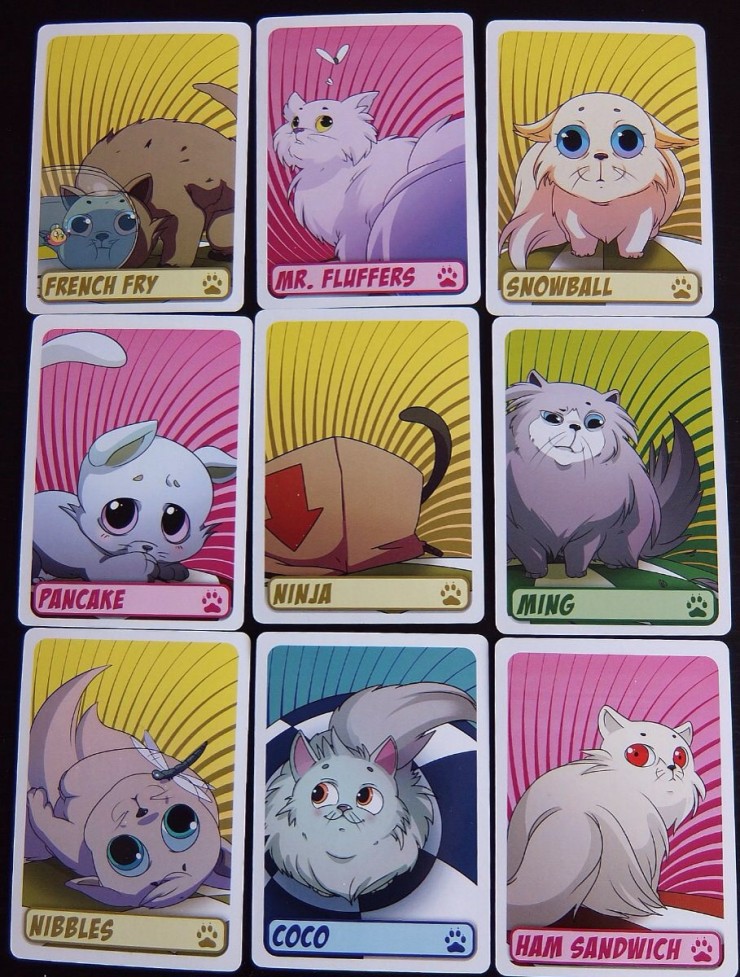 Kittens In A Blender (Cards) (Boardgame 135)
Yes. That’s the name of the game. In this card game players try to save their kittens from the blender and save as many by putting them in the box. If you feel twisted enough to put kittens in a blender, this is your chance to release that desire in a less immoral way. 2-8 players.
Kittens In A Blender (Cards) (Boardgame 135)
Yes. That’s the name of the game. In this card game players try to save their kittens from the blender and save as many by putting them in the box. If you feel twisted enough to put kittens in a blender, this is your chance to release that desire in a less immoral way. 2-8 players.

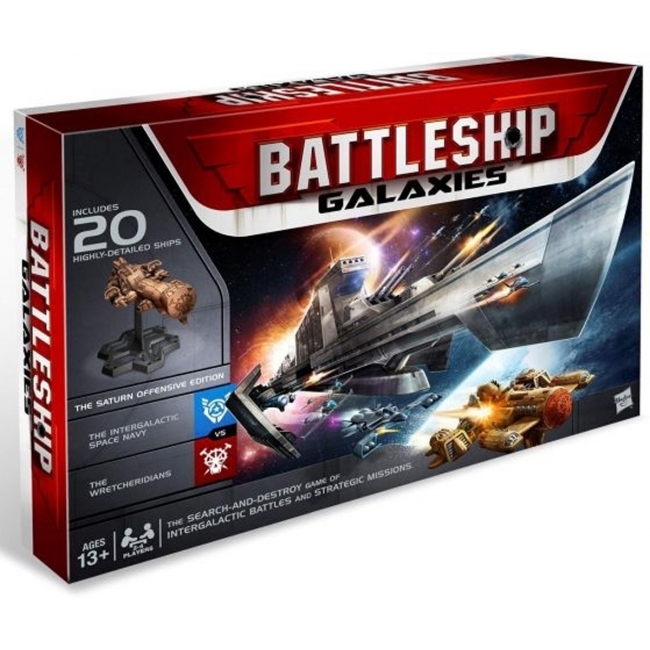 Battleship (Boardgame 17) & Battleship: Galaxies (Boardgame 73)
If war games are more your style, the media library has two different battleship games. Whether playing on sea or space, you’ll still get the chance to destroy your friends. 2-4 players.
Battleship (Boardgame 17) & Battleship: Galaxies (Boardgame 73)
If war games are more your style, the media library has two different battleship games. Whether playing on sea or space, you’ll still get the chance to destroy your friends. 2-4 players.
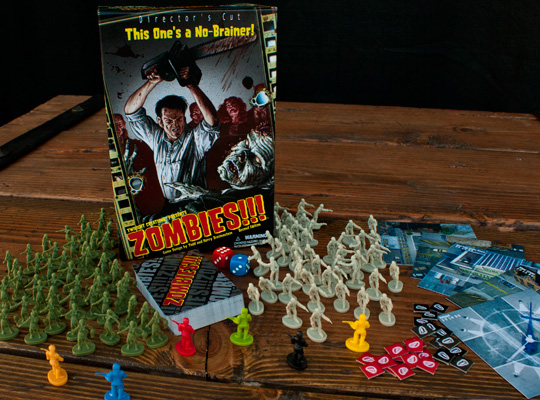 Zombies!!! (Boardgame 77)
There is never enough time to prepare for the zombie apocalypse. The goal of Zombies!!! is to be the first player to reach the center square of the “Helipad” tile, kill the zombie there and escape the advancing zombie horde. Alternately, a player also wins if he is the first to collect 25 zombies. 2-6 players.
Zombies!!! (Boardgame 77)
There is never enough time to prepare for the zombie apocalypse. The goal of Zombies!!! is to be the first player to reach the center square of the “Helipad” tile, kill the zombie there and escape the advancing zombie horde. Alternately, a player also wins if he is the first to collect 25 zombies. 2-6 players.
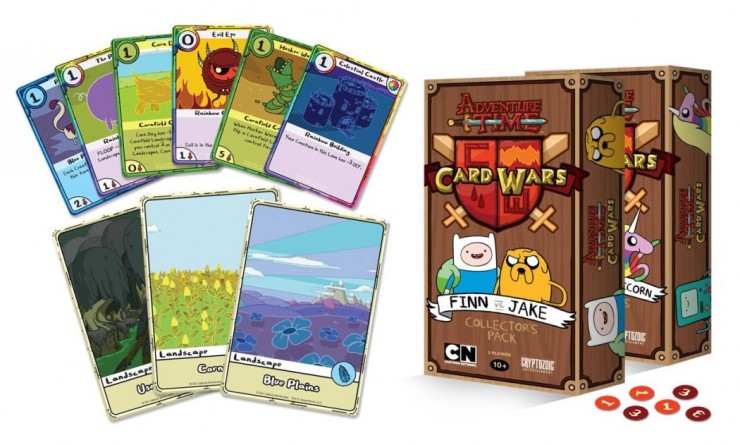 Adventure Time Card Wars (Cards) (Boardgame 218 & 252)
Guys seriously how awesome is this. Battle as Adventure Time characters with the collector packs available at the media library. 2 players.
Adventure Time Card Wars (Cards) (Boardgame 218 & 252)
Guys seriously how awesome is this. Battle as Adventure Time characters with the collector packs available at the media library. 2 players.
 Street Fighter (Cards) (Boardgame 295)
If you’re looking for a more retro option, check out Street Fighter. Choose your fighter and challenge your rivals. Take on the role of Ryu, Ken, Chun-Li, Balrog, M. Bison and others to claim yourself as the world’s best street fighter. 2-5 players.
Street Fighter (Cards) (Boardgame 295)
If you’re looking for a more retro option, check out Street Fighter. Choose your fighter and challenge your rivals. Take on the role of Ryu, Ken, Chun-Li, Balrog, M. Bison and others to claim yourself as the world’s best street fighter. 2-5 players.
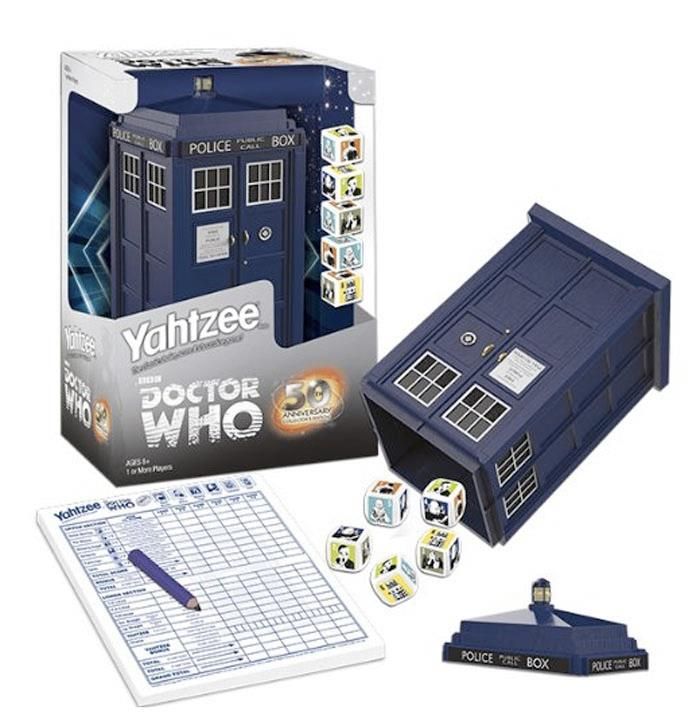 Yahtzee Dr. Who (Boardgame 235)
It’s exactly what the title implies. Shake up things with this cute little police box. Roll dice for scoring combinations and try to get the highest total score. 1+ players.
Yahtzee Dr. Who (Boardgame 235)
It’s exactly what the title implies. Shake up things with this cute little police box. Roll dice for scoring combinations and try to get the highest total score. 1+ players.
 Tummple (Boardgame 193)
Tummple is like Jenga on speed. Using plastic pebbles and wood blocks, attempt to balance in the most inconceivable manner! 2-4 players.
Tummple (Boardgame 193)
Tummple is like Jenga on speed. Using plastic pebbles and wood blocks, attempt to balance in the most inconceivable manner! 2-4 players.
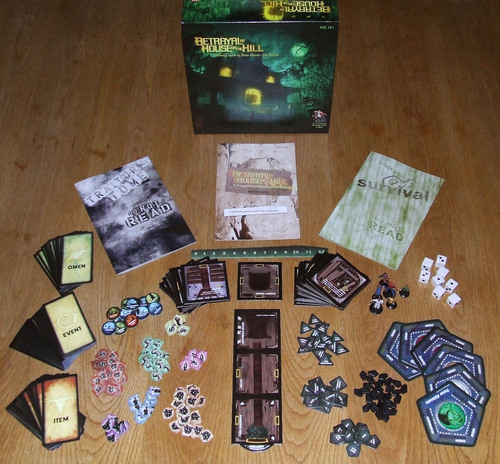
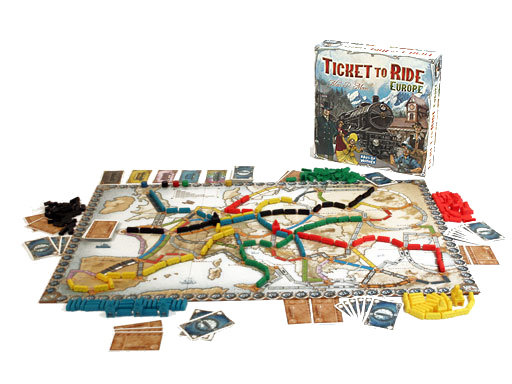 Betrayal at House on the Hill (Boardgame 39) & Ticket to Ride (Boardgame 48)
These games are available to check out of the library! Betrayal at House on the Hill is a horror-themed tile game where you build the house using haunting scenarios.3-6 players. Ticket to Ride is where players attempt to gain the most points through claiming routes and completing paths of routes. 2-5 players.
Betrayal at House on the Hill (Boardgame 39) & Ticket to Ride (Boardgame 48)
These games are available to check out of the library! Betrayal at House on the Hill is a horror-themed tile game where you build the house using haunting scenarios.3-6 players. Ticket to Ride is where players attempt to gain the most points through claiming routes and completing paths of routes. 2-5 players.
This clip from the KXAS-NBC 5 News Collection shows Warren Beatty, Estelle Parsons, and Michael J. Pollard participating in the North Texas State Fair parade in downtown Denton prior to the Southwest Premiere of Bonnie and Clyde on Sept. 13, 1967.
Much has already been written about the 1967 biographical crime film, Bonnie and Clyde. Directed by Arthur Penn and starring Warren Beatty and Faye Dunaway, this film was considered by some contemporary viewers as a groundbreaking portrayal of sex, violence, and anti-establishment sentiments while others criticized it for glamorizing violence and for inaccurate historical representations. Despite this tension between glamour and fact, exploitation and authenticity, many North Texans actually participated in the creation of Bonnie and Clyde when Hollywood stars and production crews came to towns such as Lavon, Ponder, Pilot Point, Venus, and Midlothian. The region played such a large role in the film’s production that Denton even hosted its Southwest premiere.
This September 13th, as we celebrate the 48th anniversary of the Southwest Premiere of Bonnie and Clyde, please join us for a meandering trip down memory lane and explore how the communities of North Texas participated in and influenced this historic film.
The earliest mention of Texas I’ve found concerns location shooting in Lavon in October 1966. The Wylie News reported that camera crews had been shooting at the Lavon Café (owned by Miles Williams) on Monday October 17th and Tuesday October 18th with local extras Carolyn Feagin, Mrs. Miles Williams, Billy Joe Rogers, Bob Morrow, and Mrs. W. A. Gray. From Lavon, the cast and crew moved on to Ponder, TX where Bellville resident and former Ponder resident Mrs. Leo Chatham observed the filming. Mrs. Chatham told her local paper, The Bellville Times, on November 03, 1966 that four Ponder residents had been included and “This was quite a day for the little town of Ponder.” The crew did some shooting in Dallas and then travelled back north again to shoot at the Farmers and Merchants Bank building and Mike Amon’s service station in the town of Pilot Point.
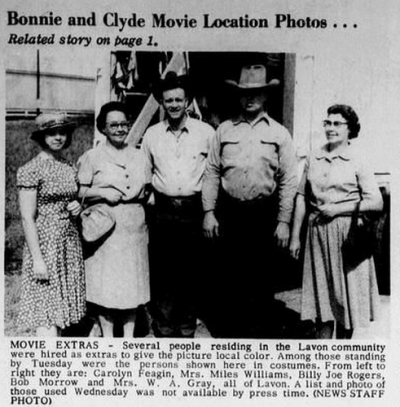 |
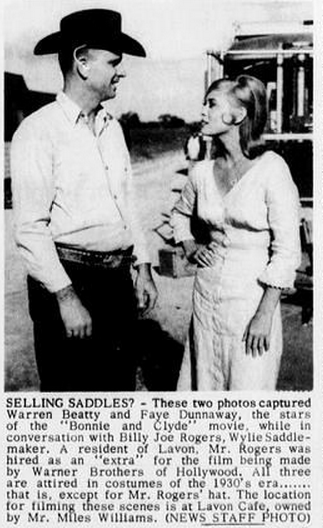 |
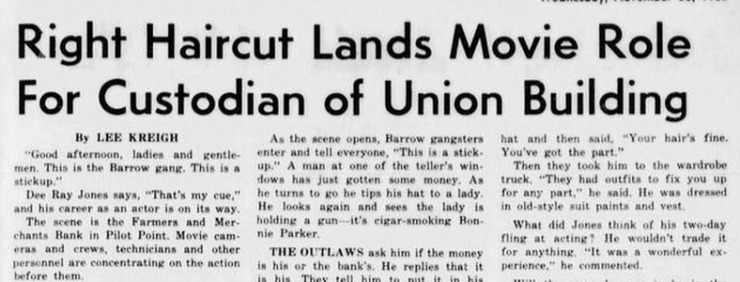 |
Newspaper reports indicate that production began in Pilot Point on Wednesday November 9th with Barrow’s bank robbery filmed at the Farmers and Merchant’s Bank. Newspaper accounts indicate that shooting continued through November 10th, though some eye-witness reports indicate the shooting may have taken at least 3 days. Local extras included relatives of Mayor George Hilz—his 11-year-old daughter Karen Hilz and nephew 14-year-old Michael Hilz. The two kids were joined by Mrs. Harold Smith (wife of then Chamber of Commerce President) during a lively getaway scene. As reported in the above clipping from The Campus Chat, North Texas State University’s (now UNT) custodian Dee Ray Jones was hired as an extra in the bank robbery scene because his haircut matched the 1930’s style better than another man considered for the job. His wife was also hired and he can purportedly be seen walking from the rear of the bank, looking through the bank teller’s window, and raising his hands.
It’s unclear when location shooting wrapped in North Texas, though one article mentioned they hoped to finish by December 1966. Local news reports about the picture slowed down until the summer of 1967 when preparations were underway for its premiere.
It’s unclear just exactly when or how it was decided that Denton, Texas would be the location for the film’s Southwest Premiere. By August 1967, however, the Campus Chat had announced that the film would receive its regional premiere in September 1967 following the New York World Premiere and a showing in Montreal. By late August, reviews from the East Coast arrived in Texas. The Pilot Point Post-Signal reported on August 31, 1967 that resident Bob Athons received a letter from his son “Sonny” Athons, an employee at the New York Daily News, who “enjoyed the film tremendously” and thought he may have spotted his father in a crowd. Mr. Athons told the Post-Signal that Sonny would be attending the Denton Premiere in September.
Taken by an unknown photographer this photograph features (left to right): Holiday Inn manager Jim Poteet, Estelle Parsons, Warren Beatty, Mrs. Jim Poteet, and Michael J. Pollard. I am still trying to locate the photographer who posted this online. Please contact me if you know who took this great photo!
On September 11th or 12th, 1967 three of the film’s stars—Warren Beatty, Estelle Parsons, and Michael J. Pollard—along with Warner Bros. executives arrived in Denton and checked-in at a local Holiday Inn. Noticeably absent was Faye Dunawaye who was shooting another film in Hollywood and unable to attend. On September 13th–the day of the premiere–they began a day-long adventure through North Texas. Taking advantage of local hospitality, Estelle Parsons was escorted around the area that morning by Denton Record Chronicle Executive Bill Rives.
Later that morning, Beatty, Parsons, and Pollard spoke at a drama seminar at the Holiday Inn. Beatty discussed accusations that the film glamorized criminals and violence: “Violence is a matter within an individual. The Depression brought on Bonnie and Clyde’s spree. They had an excuse to strike out at the Establishment and they grabbed it” (DeCola, 1967). Regarding the graphic violence and reports of 11 patrons fainting at the London screening the evening prior, Beatty told the Denton Record Chronicle “the theater was overheated” (They’re People!, 1967). Beatty also discussed the choice to use local actors and shoot on location in Texas: “We could never have attained the effect we wanted by filming it all in Hollywood, using nothing but professional actors. We felt from the start that the movie had to be filmed in this area.” He also said that the British audience had been impressed by the locally shot scenes. (DeCola, 1967). The DRC reported that in the middle of seminar, several of the students in the audience left “adhering to the school bell” prompting Beatty to feign being upset and ask the students: “Was it something I said?”
Following the seminar, the stars boarded a large bus and were taken back to the scenes of their crimes. In Ponder, they were greeted on the town square by school children dismissed from class for the occasion and were fed doughnuts and coffee. After signing autographs and posing for photos, they were back on the bus headed to Pilot Point. Unfortunately, I’ve found relatively little about the visit to Ponder.
According to the Pilot Point Post-Signal, the bus arrived at 12:40 p.m. led by a Denton County and local police escort and a crowd of “at least several hundred equipped with cameras, autograph books, and promotional material quickly encircled the plush vehicle” (Bonnie-Clyde Celebration, 1967). The crowd included children dismissed from school to participate in the festivities originally billed as “Bonnie and Clyde Day.” The actors were escorted by Chamber of Commerce President Robert Henzler to the unoccupied Farmers and Merchants State bank building where the filming took place the previous November. On the bank steps, the stars signed autographs and posed with mannequins made up to look like Bonnie and Clyde (complete with sub-machine guns). The Denton Record Chronicle noted that actor Michael J. Pollard “took a back seat to his wife” who was “easily mistaken for a starlet” and reportedly signed autographs “Mrs. Michael J. Pollard.” The Chamber of Commerce sold souvenirs including special-edition newspapers and “Bonnie Parker Cigars.” The Denton Record Chronicle reported that a Warner Bros. executive at some point during the day “climbed on a horse and showed Pilot Point residents that New Yorkers can ride too” (They’re People!, 1967). The festivities ended with a barbecue hosted by the Chamber of Commerce and catered by Jetton Catering Service of Ft. Worth. A tent was erected on the west side of town with a large portion of the square roped off and traffic re-routed. The cost for residents was $2 per plate.
After an hour and 15 minutes in Pilot Point, the group boarded their bus and returned to Denton for radio and television interviews. At some point that afternoon, it’s reported that Estelle Parsons was so hot that she jumped into the Holiday Inn pool in her street clothes (“They’re People”, 1967). Unfortunately, I found no photographs. After a full day of publicity, at 5:30 p.m. the group hopped into vintage cars and appeared in the North Texas State Fair parade (seen in the above video from the KXAS NBC 5 news collection).
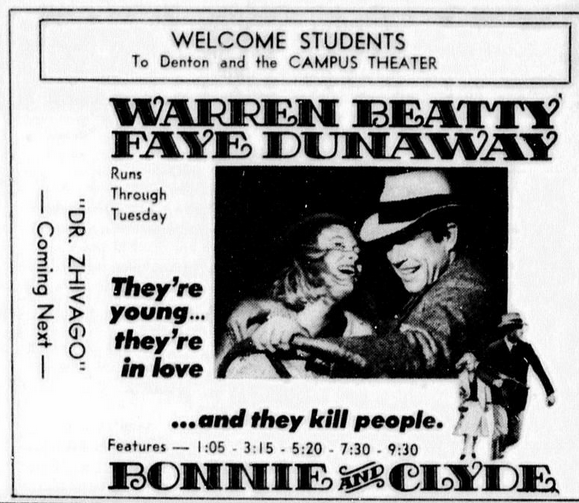 |
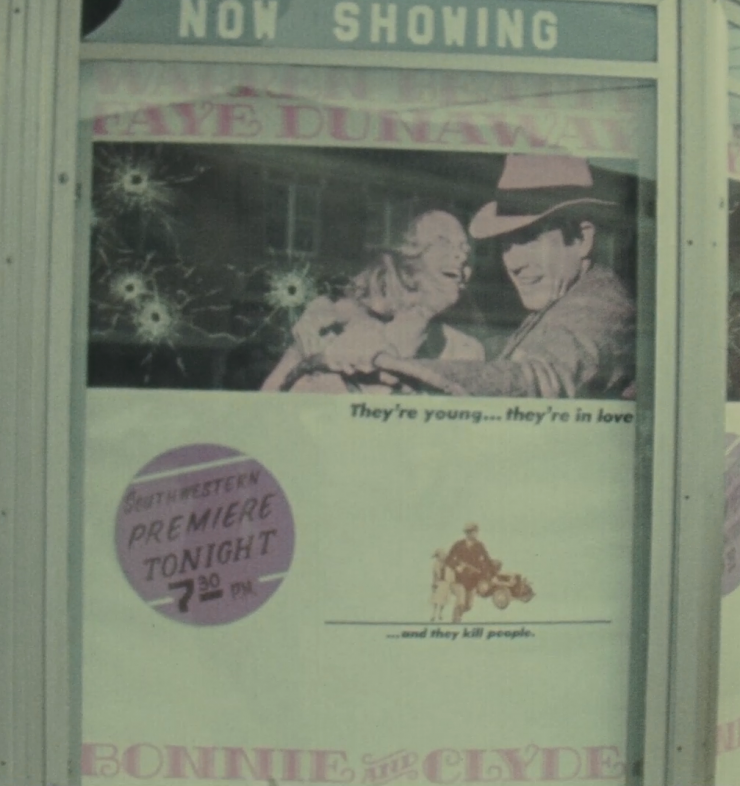 |
Clockwise: Advertisement from the Campus Chat (09/22/1967); Promotional Poster at the Campus Theater; Campus Theater Employees in the box office. Both stills are taken from the KXAS-NBC 5 film.
The Southwest premiere was scheduled for September 13th at 7:30 p.m.at Denton’s Campus Theater. The Pilot Point Post-Signal reported that portions of West Hickory had been roped off to accommodate the Denton High School Band and “a gigantic and luxurious red carpet” that was spread across the street” (Bonnie-Clyde Celebration, 1967). Ushers were in formal attire and wore new red blazers with the Interstate Theaters crest seen in the still above. The box office featured bullet-hole stickers and the words “Bonnie and Clyde Was Here.” Crowds began to gather including reporters from as far away as Detroit and Chicago. The screening was sold out but occasionally someone would turn in an unused ticket. Keith Shelton of the Denton Record Chronicle reported that “an Interstate official would hold up his hand to the crowd—just like a Texas-Oklahoma football game” and the ticket would soon be purchased. At 6:45 p.m. the doors opened to the 1,300 advance premiere ticket holders while hundreds of spectators waited for the stars to arrive. By 7:40 p.m., the stars hadn’t arrived. The band continued playing outside while audience members inside were entertained by organist Les Mills. Interstate Executive Vice President W.F. Mitchell announced that the band would get free popcorn and drinks when the event disbursed and they were through playing (Shelton, 1967).
Thirty-minutes late, at 8:00 p.m., the stars finally arrived in limousines and were rushed into the crowded theater. Once inside, Executive Editor of the Record Chronicle, Bill Rives was the master of ceremonies. The actors were invited onstage and Pollard came on stage minus one patent leather shoe stating he had tripped in the bathroom and injured his foot. Rives joked about Pollard’s velvet tuxedo and red silk turtleneck shirt, noting that Pollard was certainly “no coward” for coming to Denton in that type of ensemble (Shelton, 1967). Rives then played a tape recording from Faye Dunaway who proclaimed she could not have made it from Hollywood to Denton “no way short of using a shotgun like Bonnie Parker…at midnight your time, have a drink on me” (Shelton, 1967). Following the introductions, Beatty left but Parsons and Pollard remained for the rest of the screening.
Local reports indicate that audiences cheered loudly when their town or familiar faces were projected on the big screen. The Pilot Point Signal-Post reported (Bonnie-Clyde Celebration, 1967) that the “long awaited Pilot Point segment came about midway in the picture with thunderous applause following the local scenes as well as the appearance of local residents.” The Denton Record Chronicle reported that Pilot Point resident, 60-year-old Joe Spratt, received applause for his speaking part. Spratt, who witnessed the real Bonnie and Clyde’s 1934 visit to Grave’s Café in Pilot Point was given a speaking role as a poor farmer whose money was spared by Clyde during a robbery. The Pilot Point Signal-Post reported that Joe had been paid $100 a day for two days plus $12.50 for the use of his cows.
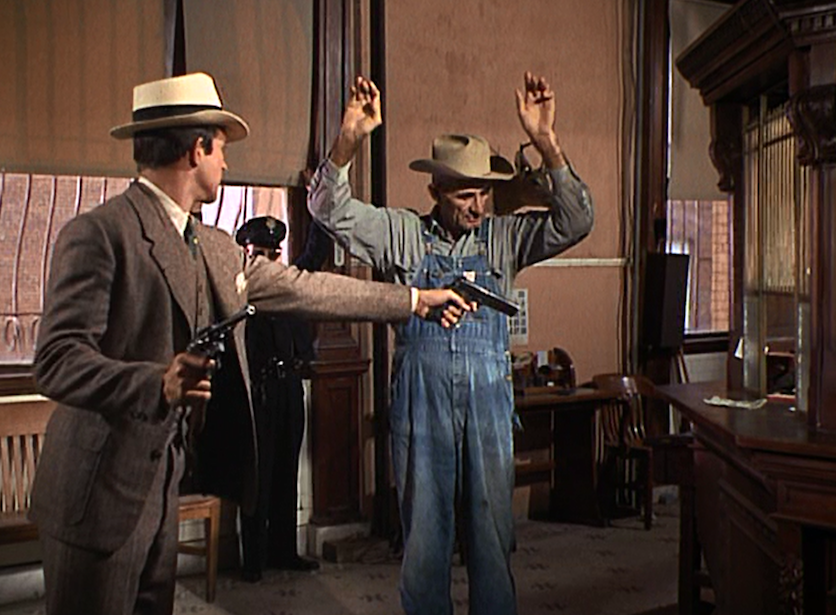 |
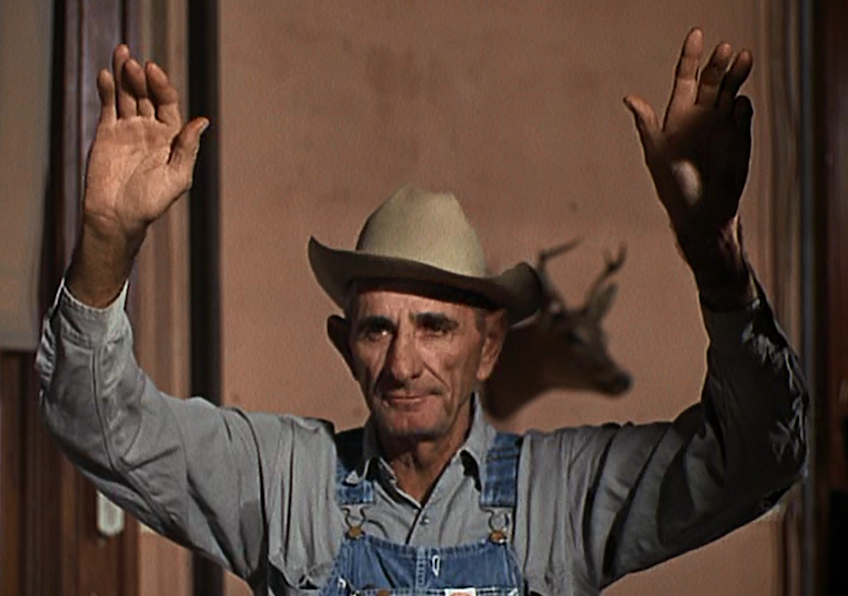 |
The following morning, the stars were escorted to Love Field and flew back to Hollywood. Though national opinion was mixed about the film and its message, Keith Shelton of the Denton Record Chronicle reported of local reaction: “most were in agreement that it was not your ordinary crime movie.” He credited the film for portraying violence and death “as real violence and death…not ‘bang, bang, you’re dead.” He observed that it was a “subdued audience” that filed out of the Campus that night. Campus Chat reporter Pat Bryan reviewed the film in the September 22nd edition of the campus paper and described Bonnie and Clyde as “real, human and true-to-life, unlike other modern Hollywood productions.” The movie, which was scheduled to run only 2 weeks, played 5 times daily at the Campus Theater to sold-out audiences. The Pilot Point Post-Signal reported on September 20th that the events were “an occasion and experience which will long be remembered among the people of this area.” Pilot Point’s mayor, George Hilz, called the production and the celebration, “the biggest thing that’s happened since I’ve been mayor.”
Bonnie and Clyde and the film about the duo continued to receive press in the North Texas papers as reviews came in from North Texans in faraway places like Georgia. The Pilot Point-Signal reported on 09/16/1967 that Mr. and Mrs. W.L. Holford had received a phone call from their daughter, Mrs. Jim Bridges, stating that they had viewed the film. The couple reported “it was nice to see their friends on screen” and that they had “spent the intermission bragging a little about Texas” (Report). The film’s message as well as its style also influenced teenagers. The Campus Chat reported on 12/15/1967 that the Zeta Tau Alpha sorority was holding a pledge party at the abandoned Farmers State Bank in Ponder (shown in the film) with pledges wearing 1930’s attire.
Outside of North Texas, the provocative film continued to receive mixed reviews though it won two Academy Awards: Best Supporting Actress for Estelle Parsons and Best Cinematography for Burnett Guffey.The film was also nominated for Best Picture, Best Director, Best Screenplay, Best Actor, Best Actress, Best Supporting Actor (for both Hackman and Pollard), and Best Costume Design. Over the last 48 years, film has remained a mainstay in best-of lists and film canons and was selected for preservation in the National Film Registry.
While the film has earned recognition, the stories of the Texans and local communities who helped make this film have yet to be fully explored. If you or someone you know has information about the filming or premiere, please contact Laura Treat, Moving Image Preservation Librarian, at laura.treat@unt.edu. I’m especially interested in talking to people who witnessed the filming and premiere and am hoping to find more information about the September 1967 promotional visit to Ponder.
If you still haven’t seen the film, you can check it out at the UNT Media Library (DVD 5866)and keep an eye open for locals. If you’re a super fan or local history enthusiast, you might consider attending Pilot Point’s “Bonnie and Clyde Days” on Saturday October 10, 2015.
Bonnie-Clyde Celebration Termed Success Here (1967, September 21). Pilot Point Post-Signal. P. 1. Bonnie-less Clyde Makes First Southwestern Showing (1967, September 22). The Campus Chat, p. 1. Bonnie and Clyde Return to Crime Scene (1967, September 07). Pilot Point Post-Signal. P. 1. Bryan, P. (1967, September 22). Screen Returns Life to ‘Bonnie and Clyde.’ The Campus Chat. P. 1. DeCola (1967, September 14). Star Trio’s Words Take New Truth. Denton Record Chronicle. Pp.1-2. Denton Set to Host Film Premiere Sept. 13 (1967, August 18). The Campus Chat. P. 4. Mrs. Chatham Watches Movie Filming (1966, November 03). The Bellville Times. P. 12. Local Sees ‘Bonnie and Clyde’ (1967, August 31). Pilot Point Post-Signal. P. 1. Location Shooting (1966, November 06). Witchita Falls Times – Features Magazine. P. 1. Pilot Point Filming Due (1966, November 07). Denton Record Chronicle. P. 1. Report on ‘Bonnie and Clyde’ (1967, September 16). Pilot Point Post-Signal. P. 1. Rives, B. (1966, November 11). The Years Roll Back for Film. Denton Record Chronicle. P. 1-2. Shelton, K. (1967, September 14). Movie Left Its Viewers to Thoughts. Denton Record Chronicle. Pp. 1-2. They’re People! Film Stars Show a Personal Touch (1967, September 14). Denton Record Chronicle. P. 1. WBAP-TV (Television station : Fort Worth, Tex.). [News Clips: LBJ Library contract, Auditor warns of county deficit, Final rites for fallen Marine, Dr. Peale criticizes rioting, Denton premier for new picture], Video, September 13, 1967; (http://texashistory.unt.edu/ark:/67531/metadc701867/ : accessed September 11, 2015). Warner Bros. Shooting Café at Lavon for Bonnie and Clyde (1966, October 20). The Wylie News. P.1.